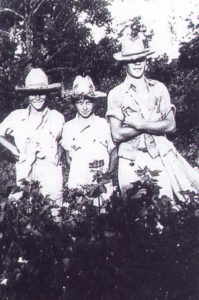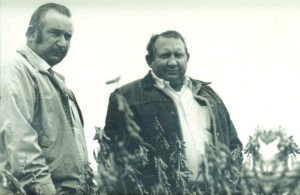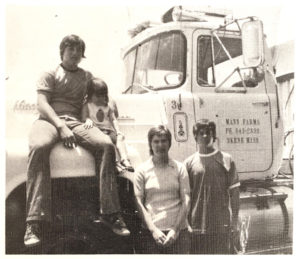By Mark H. Stowers

They plow, they plant, they pick – for generations farmers have had simple yet at times, complex jobs to perform. For many Delta area farmers farm work began with simple tasks and simple tools but decades later technology supposedly makes the simple tasks easier involving fewer and fewer farm workers. Retired farmers took time to look back on their beginnings in the field and looked at the progression of Delta farms.
Robert Naron, Bern Prewitt Sr., Billy Mann, Bill Berry, Paul Mullins, Gibb Steele and Allen Spragins each looked back on the “good ol’ days” while smiling at the technological amenities todays’ farmers enjoy.
Naron, a fourth generation Delta farmer still owns land that dates back 100 years in his family. Though he didn’t work with them his farm memories include teams of mules used to break land by his grandfather.
“My grandfather and great-grandfather moved here west of Cleveland about 100 years ago and cleared some land,” Naron says. “My great granddaddy was in the timber business. He dealt in farmland and owned farmland but he wasn’t as active in the farm. My granddaddy actually farmed from his mid-teens. When I was a kid, my granddaddy had a pair of mules but then we moved to smaller two row tractors – a Ford and then a small John Deere. I never walked behind a mule.”
Naron retired from farming due to health problems and now rents out his land.
“I farmed for 44 or 45 years,” Naron says. “I helped on the farm as I grew up.”
Along with his wife Karen, he worked the farm that was first filled with cotton and then slowly moved into grains.
“Soybeans were first getting a kick when I first started. We had cattle at one time. Cotton hit a lull in the early 1970s. We moved for a period of time to having a feed lot for cattle. That improved our cotton with the crop rotation,” Naron says.
The rotation of corn with soybeans and cotton acreage helped improve the yields of each crop and then Naron with other Delta farmers opened acreage to rice.

“We had always wanted to grow rice but it was controlled by the government by allotments,” he says. “I never was a farmer who had tremendous acreage. We had a base of land and then we rented land.”
When Naron took over the farm operation, he scaled back and simplified things.
“Trying to grow cattle and corn, soybeans, wheat, cotton and rice – cattle eventually worked out of our area and I moved more into grain crops,” he says.
Prewitt’s work on the farm included hand picking cotton back in the 1950s. The invention of the cotton picker was the best thing by far.
“The cotton picking was mostly done with labor with sacks,” he says. “The cotton picker was about the best thing to come along.”
The Prewitt farm also included dairy cattle with nearly 50 dairy cows that required plenty of attention – especially if they lost power and the electric milkers were down.
“Everybody had to get a stool then,” he says.
In addition to cotton and rice and other crops, Prewitt added the Boyle Flying Service in March of 1971 to crop dust fields. There’s been plenty of technology to advance each area of the farm as well during his farm life.
“Larger airplanes with safer equipment,” first came to mind for Prewitt.
One thing that hasn’t changed on Delta area farms is the workload. Bolivar County retired farmer, Billy Mann, noted that you never had just one job.
“I did everything on the farm,” Mann says. “I drove a tractor, hauled cotton. Did everything you do on a farm. None of us did just one thing, we all had to do it all. You’d be out in the field by about age six,” he says. “We had a few women who could drive tractors but most of them picked cotton.”
Getting an early start on the turn row has always been a rite of passage for farmers. Mann first performed small chores and working in the fields as early as he could remember. His father was an early entrepreneur with a country store along with farm land. Mann served in World War II and moved from the battle ground to the farm ground. One thing that has changed over the years is the amount of help required to run a farm, according to Mann.
“We had 10 -12 families working with us back then,” he says. “Now with airplanes and new tractors, you don’t need but one man to do the same work.”
Silver City farmer Bill Berry has seen plenty in his years on the turnrow as well.
“Field work was really in the field,” Berry says noting that they once had to hire six men to do the work of one man today.
“The crops have changed,” Berry adds. “If someone told me 20 years ago that cotton would not be king in the Delta I’d have laughed.”
Now Berry’s 1,200-acre farm grows primarily soybeans and a little corn but no cotton. He’s also witnessed the mechanization of farms that has diminished the number of families who worked farms across the Delta.
“Homes used to be part of the wage for the labor,” he says. “We furnished four houses. Farm labor lived on the farm and became part of the family. They could come to us with personal problems, family problems, or money problems and to borrow money. No one’s in those houses now.”
That sense of a true farming community was built on working together and playing together.
“The men who worked for us always carried on a bunch of foolishness,” Berry says with a laugh.
Mullins, a Cleveland area farmer since 19689, enjoyed the camaraderie away from the turnrow.
“We used to have baseball games amongst all the men,” says Mullins. “We’d get an uncle to umpire. It was all ages.”

Near Greenville, Gibb Steele recalled the livestock side of the farm as his father first raised sheep near Greenwood. His father then sold that land and moved into row crop farming in Washington County when the younger Steele was in college.
“When we moved [to Greenville] my daddy brought five men from Calhoun City and none of them had a car,” says Steele. “I was always envious of people with the tractors on the row crops.”
Steele’s favorite part of farming was driving the combine during harvest time. He also recalled that farm help tended to move around. When they would drive to pick up help, they weren’t always home.
“When we first started labor was flighty,” he says. Even though the families did not have cars, it was common for them to move from farm to farm both living and working. When I went to pick them up in the morning, I’d have to look for curtains in the window to make sure they are still there and hadn’t packed up and moved,” he says.
On Mullins farm, he would actually drive a school bus to town each day to ferry as many as 40 farm hands to the cotton fields during picking time.
Steele believes that the physically demanding work took its toll on the help combined with a longer growing season than today’s farmers have. Seed technology along with mechanization has shortened the planting and growing windows needed thus shortening the season.
“Back then, the varieties of rice and soy took longer to mature,” Steele says, explaining the harvest wouldn’t begin until the end of October. “Now we start harvesting soybeans in August.”
Technology has eased the burden of hot weather somewhat in the newer tractor era.
“Batting the weather sticks out in my mind,” says Allen Spragins who farmed 2,500 acres along Highway 82 in Washington County. “Tractors had no air conditioning. It was hard seats and long days. I always dreaded irrigation, it was the hottest part of the year.”
An air-conditioned tractor was a great relief for Mann as well but Bill Berry notes the biggest change he’s seen has to do with weeds and fertilizers—as well as satellite technology.
“I’m surprised at how clean fields are now,” he says. “We used to have to clean them by hand. Now it’s all chemicals. When I farmed, if you wanted straight rows it might take you a time or two. Now with GPS it’s automatic. It used to be a shift and a clutch, now it’s a computer.”
Mullins agrees that, “Roundup makes everyone look like a good farmer. But the air conditioner in the tractor is the best thing since sliced bread. It makes everyone less tired and less cranky.”
Communication has come from practically non-existent to a cell phone in every hand but Spragis notes the two-way radio was the first huge breakthrough for farmers.
“We would send someone to town to get a part,” he says. “By the time they left the dealership, we’d realize we needed something else and couldn’t contact them. That would be an extra 30-minute trip each way.”
In the good old days and on today’s farm, farmers wore many hats. One of the main ones is mechanic – though today’s machinery consists of computer chips along with traditional tractor parts.
“Even when I quit farming in 1999 things had gotten so complicated you couldn’t repair anything yourself anymore,” he says. “Even tractors have a computer now.”
Naron had seen plenty of technology come along and was starting to see plenty of GPS in the tractor cab before he retired.
“In my 71 years, I’ve seen it go from mules to self-driving tractors,” he says. “But now the man operating the equipment has to be much more talented – fluent in computer and technology.”
Advances in chemical technology as well as the growing size and power of tractors have made things maybe a bit easier but still complex in making farm work efficient and timely.
“Now, you spray roundup in January or February so your fields don’t grow up with weeds,” says Steele. “We used to do half or more of our tillage in the Spring. Now we don’t do hardly any.”
The late harvest and rains made for problems in field preparation.
“During those late harvests, it was always wet and you made a lot of ruts,” he adds. “You had these huge tractor tracks through the field so you couldn’t hardly get the field prepared in time for the next year. It was really ugly trying to get a field ready.”
It may have been hard work but none of the farmers would trade the vocation or the experience for anything else. Naron notes he enjoyed the “out of doors” work and “being your own boss and the challenges of each day.”
While most farmers were “handed down” their farm education, later generations would attend local junior and senior colleges for business, ag econ and other such degrees. But there was also the help from the Mississippi State extension office that has spanned more than 100 years of helping farmers. Naron took full advantage of this “free” education beginning with his involvement in 4H Clubs.
“I always say, ‘I might not be the sharpest knife in the drawer but I knew when to ask for help.’ I always tried to use their good advice. You always need a good accountant, good lawyer and a good crop advisor,” he says.
And many farmers have had help and counsel from local and state Farm Bureau personnel.
“Farm Bureau has been a real source for farmers across the state and nation,” Naron says. “I feel like they are the best voice for all of agriculture in the government.”
One thing that never changes – the blessings that come with being raised on a family farm.
“My favorite part was being able to raise kids on a farm,” Berry says. “The go with me to the field, play on the cotton trailers and play with the workers’ kids. I’m just blessed that they grew up in that atmosphere.”
And with so many helping hands, the kids were always tended to no matter what.
“We always had 100 yards away,” says Steele. “The good part is you’re working with your family, but as generations get older, you start to bump heads. When I was in my early 30s my daddy retired and let me take over. That gave me the courage when my son was about 30 and we started to bump heads. He says, ‘it’s about time one of us needs to play more golf,’ and I decided that should be me. Gradually I’ve handled less and less of the day to day worry.”
There may be fewer hands to get the work done and technology keeps marching along but the farm life is one that truly never changes from generation to generation—it’s just a bit more air conditioned with straighter and cleaner rows.
